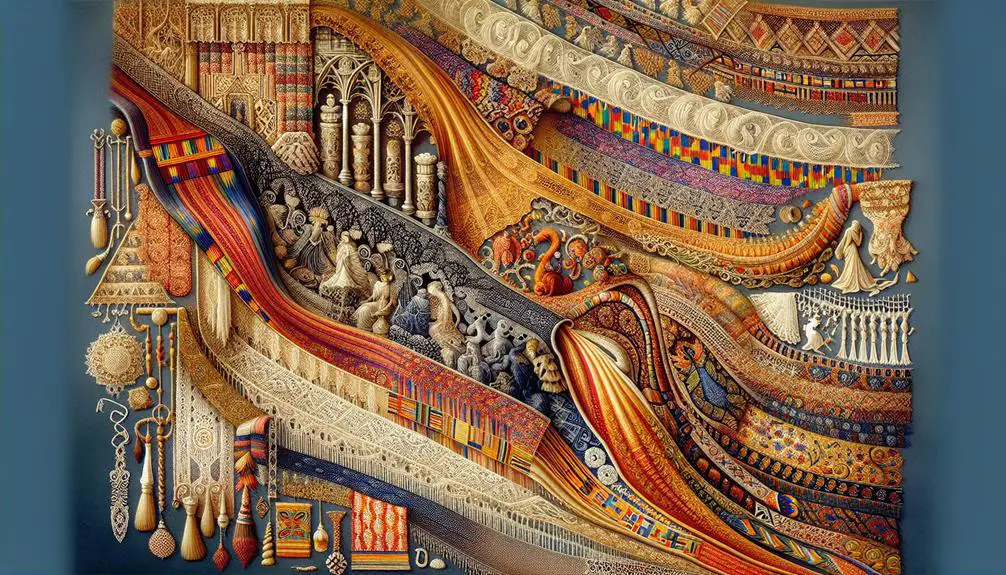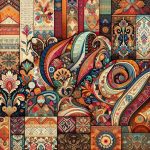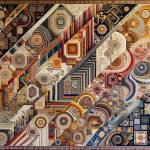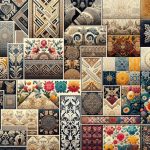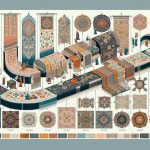Just as Odysseus set off on his epic journey, textile patterns have journeyed through time, weaving rich narratives into the fabric of history. You might find it fascinating how Ancient Egyptian motifs, laden with symbolic meaning, gave way to the geometric precision of Islamic art. These patterns didn't just adorn fabrics; they told stories of cultural evolution and technological progress. From Medieval Europe's opulent tapestries to the democratized designs of the Industrial Revolution, each era left its mark. Curious about how these intricate designs have shaped our modern textiles? Let's explore this journey together.
Table of Contents
Key Takeaways
- Ancient textile patterns featured intricate symbolism, vibrant colors, and repetitive motifs like lotus flowers and hieroglyphs.
- Medieval European textiles showcased opulent tapestries and needlework blending local and imported styles through exceptional craftsmanship.
- Islamic and Persian textiles excelled in geometric and floral motifs, often incorporating calligraphy for aesthetic and spiritual significance.
- The Industrial Revolution democratized fashion with mechanized looms, making fabrics accessible and transforming societal structures.
- Modern textile patterns blend traditional craftsmanship with technology, embracing minimalist aesthetics, digital printing, and smart textiles.
Ancient Egyptian Motifs
Ancient Egyptian motifs, characterized by their intricate symbolism and vibrant colors, offer a fascinating glimpse into the civilization's rich cultural heritage. You'll find that these designs aren't just visually appealing but are also steeped in profound symbolic meanings.
Hieroglyphic symbols, for instance, are more than mere writing; they're a visual language that conveys deeper truths about life, death, and the divine. When you explore these symbols, you'll notice how they're meticulously integrated into textile patterns, weaving stories and beliefs into the fabric itself.
Repetitive motifs are another hallmark of Ancient Egyptian textiles. These motifs often feature intricate details that showcase the artistry and precision of Egyptian craftsmen. Think of the lotus flower, a symbol of rebirth, or the ankh, representing eternal life. These elements aren't randomly placed but are carefully repeated to create a harmonious and balanced design.
When you investigate these patterns, you'll appreciate the level of thought and intention behind each element. Understanding these motifs gives you a more nuanced appreciation of how the Egyptians viewed their world and expressed their values through their art.
Classical Greek and Roman Designs
Classical Greek and Roman designs, with their geometric patterns and mythological themes, reflect a sophisticated blend of artistry and cultural significance. You'll find that Greek Key patterns, also known as meanders, are a hallmark of Greek textiles. These intricate, continuous lines symbolize unity and infinity. Roman textiles, on the other hand, often feature Roman Mosaics, showcasing elaborate scenes and sophisticated geometric arrangements.
To better understand these designs, consider the following table:
| Design Element | Greek Key | Roman Mosaic |
|---|---|---|
| Origin | Greece | Rome |
| Symbolism | Unity, Infinity | Artistic Expression, Storytelling |
| Common Usage | Borders, Friezes | Floor Designs, Wall Art |
| Key Features | Geometric, Continuous Lines | Tessellated Patterns, Narrative Scenes |
| Cultural Impact | Strong influence on Western art and architecture | Integral to Roman interior design |
In both cultures, textiles weren't just functional; they were canvases for artistic expression and storytelling. Greek Key patterns adorned clothing and household items, offering a timeless aesthetic that's still popular today. Roman Mosaics, meanwhile, transformed ordinary spaces into visual narratives, reflecting the grandeur of Roman life. By mastering these elements, you'll appreciate the depth and beauty of classical textile patterns.
Medieval European Textiles
Medieval European fabrics, with their opulent tapestries and intricate needlework, offer a glimpse into the era's artistry and cultural narratives. When you explore these medieval tapestries, you'll notice the exceptional craftsmanship that went into each piece. Artists used intricate patterns to tell stories, depict religious scenes, and illustrate everyday life. These fabrics weren't just decorative; they served as historical records, capturing the essence of medieval society.
The European fabric trade played a vital role in spreading these intricate patterns across the continent. Merchants traveled far and wide, bringing new materials and designs to different regions. This exchange of ideas and goods enriched the fabric landscape, leading to a captivating blend of local and imported styles. You can see this in the way patterns evolved, incorporating elements from various cultures and traditions.
Mastery of fabric craftsmanship was highly esteemed, with guilds and workshops dedicated to the art. Skilled artisans spent years perfecting their techniques, ensuring that each piece was a tribute to their expertise.
Islamic and Persian Influences
When you explore Islamic and Persian textiles, you'll notice the mastery of geometric motifs that create intricate and mesmerizing designs.
These cultures also influenced the evolution of floral patterns, adding a unique blend of natural elements.
Additionally, the integration of calligraphy in textiles showcases their artistic approach to incorporating script into fabric.
Geometric Motifs Mastery
Explore the mesmerizing world of geometric motifs, where Islamic and Persian artisans masterfully crafted intricate designs that continue to captivate and inspire.
You'll find that these artisans didn't just create patterns; they achieved a level of mastery by skillfully combining geometric shapes like squares, triangles, and hexagons into complex, abstract designs. Each pattern holds a sense of rhythm and balance, reflecting a deep understanding of mathematical principles and an eye for aesthetic harmony.
To truly appreciate this artistry, you must look at how these designs were meticulously constructed. Islamic and Persian weavers utilized a technique known as tessellation, where shapes are repeated without gaps or overlapping. This method allowed them to produce seamless, flowing patterns that seem almost infinite.
The precision required for such work demonstrates their commitment to perfection and their deep reverence for geometry as a divine language.
Floral Patterns Evolution
Floral patterns in Islamic and Persian art developed into intricate designs that capture the delicate beauty of nature while showcasing exceptional craftsmanship. You'll find that these patterns often stem from deep botanical inspirations, reflecting the region's lush gardens and rich flora. The cultural importance of floral designs lies in their symbolism of paradise and eternal life, often woven into textiles to convey these profound themes.
Islamic and Persian artists have historically employed a blend of realistic and stylized artistic interpretations, pushing the boundaries of design progression. The shift from simple to complex patterns showcases their skill in manipulating shapes and colors to create captivating visuals.
Here's a quick breakdown of key elements:
| Element | Description | Significance |
|---|---|---|
| Botanical Inspirations | Drawn from regional flora | Represents nature and paradise |
| Cultural Significance | Symbolism in textiles | Conveys spiritual and cultural messages |
| Artistic Interpretations | Blend of realistic and stylized designs | Showcases artistic prowess and creativity |
| Design Progression | From simple to intricate patterns | Reflects advancements in craftsmanship |
| Craftsmanship | High level of detail and precision | Demonstrates mastery and dedication |
Calligraphy in Textiles
In addition to the intricate floral patterns, Islamic and Persian textiles often feature calligraphy that elevates the fabric's aesthetic and spiritual significance. You'll find that calligraphy isn't just about beautiful script; it's a profound expression of cultural and religious values.
The use of Arabic script in Islamic textiles often includes verses from the Quran, invoking divine protection and blessings. Persian textiles, on the other hand, might incorporate poetry by luminaries like Rumi or Hafez, weaving words of wisdom directly into the fabric.
These textiles employ intricate details that demand a high level of craftsmanship. You'll notice that each stroke and curve of the script is meticulously planned and executed, reflecting both artistry and devotion.
The cultural significance of incorporating calligraphy into textiles extends beyond decoration; it serves to preserve and propagate literary and religious heritage. When you study these pieces, you're not just looking at fabric; you're engaging with centuries of history and spirituality.
Asian Silk Road Patterns
Along the ancient trade routes of the Silk Road, textile patterns flourished and evolved, reflecting a rich tapestry of cultural exchange. You'll notice the profound Chinese influence in the intricate details of the designs. Chinese artisans mastered the art of weaving and dyeing, creating textiles adorned with dragons, phoenixes, and floral motifs, which weren't only aesthetically pleasing but also symbolically significant. These patterns demonstrated their unparalleled skill and a deep respect for tradition.
Moving along the route, you encounter Indian textiles, which are renowned for their vibrant colors and dynamic patterns. Indian craftsmen employed techniques such as block printing and tie-dyeing to produce fabrics that were both visually striking and culturally meaningful. The use of natural dyes from plants like indigo and madder resulted in rich hues that stood the test of time. These textiles often featured motifs inspired by nature, mythology, and daily life, showcasing an incredible balance of artistry and function.
In your exploration of the Asian Silk Road patterns, you'll see how these diverse influences merged, creating a unique and enduring legacy in the world of textiles. Each piece tells a story of exchange, adaptation, and innovation.
Industrial Revolution Changes
You'll notice a dramatic shift in textile patterns as the Industrial Revolution ushered in new technologies and mass production methods. The advent of mechanized looms and spinning machines revolutionized textile production. Previously handcrafted patterns gave way to intricate designs produced at unprecedented speeds. These technological advancements allowed for the replication of complex motifs that were once labor-intensive, democratizing fashion and making elaborately patterned fabrics accessible to a broader audience.
The social impact of these changes can't be understated. Factories sprouted up across Europe and North America, employing thousands. However, the factory conditions were often harsh and dehumanizing. Workers, including children, toiled long hours in poorly ventilated, dimly lit spaces, with little regard for safety. Despite these conditions, the sheer volume of textile production led to a proliferation of new patterns and styles, fundamentally altering the landscape of fashion and interior design.
As you explore further into this era, you'll see how technological advancements in textile production didn't just change patterns—they transformed societal structures. The Industrial Revolution's legacy in textile design is a testimony to human ingenuity and the intricate interplay between technology and social dynamics.
Modern and Contemporary Styles
Today's textile patterns reflect a blend of traditional craftsmanship and cutting-edge technology, resulting in innovative and diverse designs. You'll find that modern styles often embrace minimalist aesthetics, focusing on clean lines and subtle textures. This approach emphasizes the beauty of simplicity and material quality, making each piece feel both contemporary and timeless.
By stripping away the unnecessary, minimalist designs allow the fabric itself to take center stage, highlighting its natural elegance.
On the other hand, avant-garde influences push the boundaries of textile design, encouraging experimentation and boldness. These patterns often feature unexpected combinations of colors, shapes, and materials, challenging conventional norms.
By incorporating avant-garde elements, you can create textiles that aren't just functional but also strikingly artistic. This innovative spirit is evident in the use of digital printing and smart textiles, which integrate technology to produce interactive and dynamic patterns.
To master the art of modern textile design, it's essential to balance these minimalist and avant-garde influences. By doing so, you'll create pieces that are both sophisticated and forward-thinking, appealing to those who appreciate innovation and craftsmanship.
Frequently Asked Questions
How Have Traditional Textile Patterns Influenced Modern Fashion Trends?
While you might think modern fashion is entirely new, traditional influences play a huge role. You'll see modern interpretations of classic patterns, seamlessly blending history with innovation, proving that old designs can still inspire contemporary styles.
What Are the Environmental Impacts of Textile Production?
You're concerned about textile production's environmental impacts. By adopting sustainable practices and using eco-friendly materials, you'll reduce waste and improve pollution control. Prioritize waste management, and you'll lessen the industry's ecological footprint to a great extent.
How Do Textile Patterns Vary Between Different Cultures?
You'll notice textile patterns vary widely across cultures due to diverse cultural influences and traditional techniques. In one region, you might find intricate embroidery, while another showcases bold, geometric prints. Each pattern tells a unique cultural story.
What Are the Common Techniques Used in Textile Pattern Creation?
To master textile pattern creation, you'll use various techniques. Block printing and screen printing offer precision, while weaving techniques add texture. Embroidery provides intricate, hand-crafted details. Each method elevates your work's uniqueness and artistry.
How Has Digital Technology Transformed Textile Pattern Design?
Imagine a world where your creativity knows no bounds! Digital transformation has revolutionized textile pattern design, enabling you to craft innovative designs effortlessly. You'll find endless possibilities with cutting-edge software and tools at your fingertips.
- Sourcing Duchess Satin Fabric in South Africa: Your Go-To Guide - June 24, 2025
- Where to Buy Duchess Satin Fabric in Australia: Top Suppliers and Shops - June 24, 2025
- Duchess Satin Fabric Care: How to Wash and Maintain Your Garments - June 24, 2025

